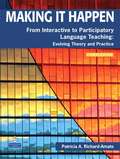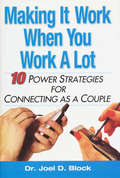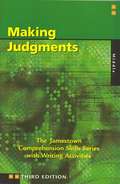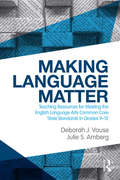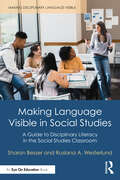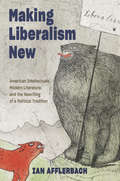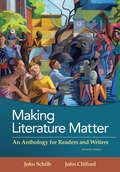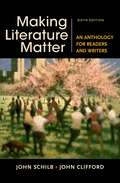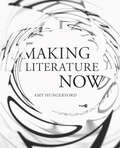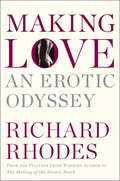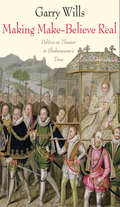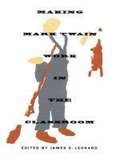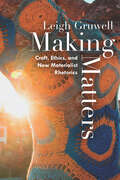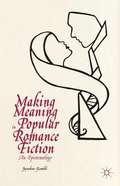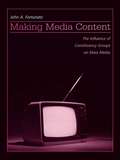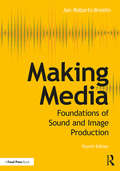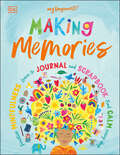- Table View
- List View
Making It Happen, from Interactive to Participatory: Language Teaching, Evolving Theory and Practice (4th Edition)
by Patricia A. Richard-AmatoNew to this edition: Separate chapters on implicit/explicit teaching and on a sociocultural/cognitive synthesis. New sections on focus form strategies, World Englishes, research directions, corpus analysis, dialogical assessment, and the Acoma heritage language program. The research has been updated throughout and reflects influential thinking for the 21st century. Part 1: Theoretical Considerations - Explores current theory and research; builds a case for emergent participatory teaching; and highlights literacy development, self-directed learning strategies, and current assessment issues and practices. Part II: Exploring Methods and Activities - Presents a practical reservoir from which teacher can draw as they develop their own methodologies and local practice. Part III: Putting It All Together: Some Practical Issues - Considers issues critical to program development, lesson design, textbook and computer program selection, video use; teacher research and professional development (including SOP). Part IV: Programs in Action - Describes K-Adult Programs (ESL, Foreign Language, Bilingual, and Tribal Heritage). Part V: Case Studies: Teacher Narrations to Stimulate Professional Dialogue - Presents case studies, ranging from kindergarten through university levels.
Making It Work When You Work A Lot: 10 Power Strategies For Connecting As A Couple
by Joel D. BlockA sampling of real-life stories behind the curtain in the executive suite: Marion has a ten-percent marriage. Her husband is on the road eighty percent of the time and catches up on sleep half of the time he is at home. She uses innovative techniques to save her relationship. The neglect and resentment Joyce felt as a result of her husband Paul's extraordinary work schedule was temporarily eased by her fling with a former colleague. She confessed her infidelity to Paul--and they're still together! Learn about repair strategies that are tried and proven. Rob, a stay-at-home dad, also considered having an affair. He's come up with a better solution, one that saved his marriage as well as his ego. Kevin had developed an intriguing method for keeping Janice at a distance. We'll see how Janice reacted and what they did to bring value back to their relationship. Alex badgered Florence about her housekeeping, then acknowledged that his beef was Florence's meteoric career progression, especially since his career had stalled. Unlike many other couples where the wife is the bigger earner, Florence and Alex worked things out brilliantly. These successful couples have confronted--and overcome--the considerable challenges of balancing work and home life by focusing on the bottom line: strategies for maintaining the vitality, energy, and love that first brought them together. In this groundbreaking guide, relationship specialist Dr. Joel Block will show you what they did, how they did it, and how you can, too. Let this book be your portable relationship coach--the ultimate resource for Making It Work When You Work a Lot. Dr. Joel Block is a clinical psychologist specializing in couples therapy. His success in treating hundreds of devastated executive marriages over the years has led him to formulate a blueprint for success that addresses the challenges that are unique to these relationships. Making It Work When You Work a Lot is a real-life action plan with the mission of protecting executive marriages. It was formulated after interviews with nearly one hundred executives and their spouses, men and women from across the country. Each chapter is derived from the specific concerns of executives struggling to make their marriages work. As you will discover, the issues they raised involve competencies that are also crucial in the world of business. Dr. Block shows you how solutions to problems encountered in the workplace translate directly to successful resolutions of similar challenges at home: 1.
Making Judgments (Jamestown Comprehension Skills)
by Jamestown Education Staff<p>Spend more time teaching to each student's needs while the computer takes care of tracking progress. <p> <li>Improve fiction and nonfiction comprehension <li>Customize instruction for each student with computerized placement test <li>Move beyond skill-and-drill with integrated writing activities</li> <p> <p>This innovative program helps students devote effort to only those specific comprehension skills that give them trouble. The computerized testing system diagnoses weaknesses and prescribes proper placement in Comprehension Skills books. While the computer manages the data, you can concentrate on instruction, expanding comprehension skills with a five-part lesson plan proven to succeed. Computerized follow-up testing tracks progress by comparing "before" and "after" results.</p>
Making Language Matter: Teaching Resources for Meeting the English Language Arts Common Core State Standards in Grades 9-12
by Deborah J. Vause Julie S. AmbergNow adopted by over 40 states, the Common Core State Standards provide a clear and consistent framework for public school systems as they develop student learning goals that define the path to readiness for college, careers, and informed citizenship. While each state is developing its own procedures for adoption of the Standards, individual teachers will continue to hold the ultimate responsibility for devising lesson plans and tailoring instruction to meet these benchmarks. Making Language Matter will help prospective and practicing teachers develop lessons to meet the benchmarks enumerated in the Standards for the English Language Arts categories: language, speaking and listening, writing, and reading. A timely text for literacy education courses, it explores language topics within these categories and suggests pedagogical approaches and activities for use in 9-12 language arts classrooms. Using a linguistics approach to unify the study of all the language arts, it engages readers in learning how to help students make purposeful language choices essential for both academic and workplace success.
Making Language Visible in Social Studies: A Guide to Disciplinary Literacy in the Social Studies Classroom (Making Disciplinary Language Visible)
by Ruslana Westerlund Sharon BesserAs the first book in the Making Disciplinary Language Visible series, this practical toolkit helps teachers promote disciplinary literacy development for Multilingual learners and their peers in the 5–12 social studies classroom. Using systemic functional linguistics (SFL) and the SFL-informed genre pedagogy, the Teaching and Learning Cycle for Disciplinary Genres, the book shows teachers how to teach content using language as a meaning-making resource. Besser and Westerlund provide clear guidance on understanding how language is used in the discipline and provide practical tools to empower teachers to teach language in the service of social studies disciplinary genres. Chapters feature authentic vignettes to illustrate problems of practice, annotated social studies texts, practical curriculum design tools, exercises for readers to develop knowledge about language, and sample scripts for practical application.
Making Liberalism New: American Intellectuals, Modern Literature, and the Rewriting of a Political Tradition (Hopkins Studies in Modernism)
by Ian AfflerbachA revisionist history of American liberalism, from the Great Depression to the Cold War.In Making Liberalism New, Ian Afflerbach traces the rise, revision, and fall of a modern liberalism in the United States, establishing this intellectual culture as distinct from classical predecessors as well as the neoliberalism that came to power by century's end. Drawing on a diverse archive that includes political philosophy, legal texts, studies of moral psychology, government propaganda, and presidential campaign materials, Afflerbach also delves into works by Tess Slesinger, Richard Wright, James Agee, John Dewey, Lionel Trilling, and Vladimir Nabokov. Throughout the book, he shows how a reciprocal pattern of influence between modernist literature and liberal intellectuals helped drive the remarkable writing and rewriting of this keyword in American political life. From the 1930s into the 1960s, Afflerbach writes, modern American fiction exposed and interrogated central concerns in liberal culture, such as corporate ownership, reproductive rights, color-blind law, the tragic limits of social documentary, and the dangerous allure of a heroic style in political leaders. In response, liberal intellectuals borrowed key values from modernist culture—irony, tragedy, style—to reimagine the meaning and ambitions of American liberalism. Drawing together political theory and literary history, Making Liberalism New argues that the rise of American liberal culture helped direct the priorities of modern literature. At the same time, it explains how the ironies of narrative form offer an ideal medium for readers to examine conceptual problems in liberal thought. These problems—from the abortion debate to the scope of executive power—remain an indelible feature of American politics.
Making Literature Matter
by John Schilb John Clifford"Making Literature Matter" combines an innovative writing text with a uniquely organized anthology for introductory literature courses that emphasize critical thinking and writing. The third edition addresses new trends in literature and composition, with more instruction on writing arguments and unique clusters that pair literary and visual texts for analysis.
Making Literature Matter: An Anthology for Readers and Writers
by John Schilb John CliffordStudents have always responded powerfully to the memorable stories, poems, plays, and essays gathered in distinctive clusters in Making Literature Matter's thematic anthology. At the same time, the book's chapters on reading, writing and research help students harness those responses into persuasive, well-supported arguments about the issues raised by the literature. As ever, the new edition of Making Literature Matter reflects John Schilb and John Clifford's careful attention to emerging pedagogical needs and trends. In response to instructor requests, they have expanded their treatment of argumentation and research, and refined their approach to literary genres. Further, they read widely to identify some of the most engaging fiction, poetry, drama, and nonfiction published recently, and based their new choices for the sixth edition on how well that literature raises and explores issues that matter to students right now.
Making Literature Now
by Amy HungerfordHow does new writing emerge and find readers today? Why does one writer's work become famous while another's remains invisible? Making Literature Now tells the stories of the creators, editors, readers, and critics who make their living by making literature itself come alive. The book shows how various conditions--including gender, education, business dynamics, social networks, money, and the forces of literary tradition--affect the things we can choose, or refuse, to read. Amy Hungerford focuses her discussion on literary bestsellers as well as little-known traditional and digital literature from smaller presses, such as McSweeney's. She deftly matches the particular human stories of the makers with the impersonal structures through which literary reputation is made. Ranging from fine-grained ethnography to polemical argument, this book transforms our sense of how and why new literature appears--and disappears--in contemporary American culture.
Making Love
by Richard RhodesA brilliant and illuminating exploration of one man's sexual odyssey, written by the Pulitzer Prize-winning author of The Making of the Atomic Bomb and A Hole in the World.Making Love marks the first time a major author has written with such unapologetic candor of his most intimate experiences, fantasies, and thoughts. From his sexual coming of age to his work with ESO (Extended Sexual Orgasm), Richard Rhodes has created both an insightful memoir and a provocative treatise on sex, taboo, love, and power.
Making Love in the Twelfth Century: "Letters of Two Lovers" in Context
by Barbara NewmanNine hundred years ago in Paris, a teacher and his brilliant female student fell in love and chronicled their affair in a passionate correspondence. Their 116 surviving letters, some whole and some fragmentary, are composed in eloquent, highly rhetorical Latin. Since their discovery in the late twentieth century, the Letters of Two Lovers have aroused much attention because of their extreme rarity. They constitute the longest correspondence by far between any two persons from the entire Middle Ages, and they are private rather than institutional--which means that, according to all we know about the transmission of medieval letters, they should not have survived at all. Adding to their mystery, the letters are copied anonymously in a single late fifteenth-century manuscript, although their style and range of reference place them squarely in the early twelfth century.Can this collection of correspondence be the previously lost love letters of Abelard and Heloise? And even if not, what does it tell us about the lived experience of love in the twelfth century?Barbara Newman contends that these teacher-student exchanges bear witness to a culture that linked Latin pedagogy with the practice of ennobling love and the cult of friendship during a relatively brief period when women played an active part in that world. Newman presents a new translation of these extraordinary letters, along with a full commentary and two extended essays that parse their literary and intellectual contexts and chart the course of the doomed affair. Included, too, are two other sets of twelfth-century love epistles, the Tegernsee Letters and selections from the Regensburg Songs. Taken together, they constitute a stunning contribution to the study of the history of emotions by one of our most prominent medievalists.
Making Make-Believe Real
by Garry WillsShakespeare's plays abound with kings and leaders who crave a public stage and seize every opportunity to make their lives a performance: Antony, Cleopatra, Richard III, Othello, and many others. Such self-dramatizing characters appear in the work of other playwrights of the era as well, Marlowe's Edward II and Tamburlaine among them. But Elizabethan playwrights were not alone in realizing that a sense of theater was essential to the exercise of power. Real rulers knew it, too, and none better than Queen Elizabeth. In this fascinating study of political stagecraft in the Elizabethan era, Garry Wills explores a period of vast cultural and political change during which the power of make-believe to make power real was not just a theory but an essential truth. Wills examines English culture as Catholic Christianity's rituals were being overturned and a Protestant queen took the throne. New iconographies of power were necessary for the new Renaissance liturgy to displace the medieval church-state. The author illuminates the extensive imaginative constructions that went into Elizabeth's reign and the explosion of great Tudor and Stuart drama that provided the imaginative power to support her long and successful rule.
Making Mark Twain Work in the Classroom
by James S. LeonardHow does one teach Mark Twain's Huckleberry Finn, a book as controversial as it is central to the American literary canon? This collection of essays edited by James S. Leonard offers practical classroom methods for instructors dealing with the racism, the casual violence, and the role of women, as well as with structural and thematic discrepancies in the works of Mark Twain. The essays in Making Mark Twain Work in the Classroom reaffirm the importance of Twain in the American literature curriculum from high school through graduate study. Addressing slavery and race, gender, class, religion, language and ebonics, Americanism, and textual issues of interest to instructors and their students, the contributors offer guidance derived from their own demographically diverse classroom experiences. Although some essays focus on such works as A Connecticut Yankee in King Arthur's Court and The Innocents Abroad, most discuss the hotly debated Adventures of Huckleberry Finn, viewed alternately in this volume as a comic masterpiece or as evidence of Twain's growing pessimism--but always as an effective teaching tool. By placing Twain's work within the context of nineteenth-century American literature and culture, Making Mark Twain Work in the Classroom will interest all instructors of American literature. It will also provoke debate among Americanists and those concerned with issues of race, class, and gender as they are represented in literature.Contributors. Joseph A. Alvarez, Lawrence I. Berkove, Anthony J. Berret, S.J., Wesley Britton, Louis J. Budd, James E. Caron, Everett Carter, Jocelyn Chadwick-Joshua, Pascal Covici Jr., Beverly R. David, Victor Doyno, Dennis W. Eddings, Shelley Fisher Fishkin, S. D. Kapoor, Michael J. Kiskis, James S. Leonard, Victoria Thorpe Miller, Stan Poole, Tom Reigstad, David E. E. Sloane, David Tomlinson
Making Matters: Craft, Ethics, and New Materialist Rhetorics
by Leigh GruwellCraft is a process-oriented practice that takes seriously the relationships between bodies—both human and nonhuman—and makes apparent how these relationships are mired in and informed by power structures. Making Matters introduces craft agency, a feminist vision of new materialist rhetorics that enables scholars to identify how power circulates and sometimes stagnates within assemblages of actors and provides tools to rectify that uneven distribution. To recast new materialist rhetorics as inherently crafty, Leigh Gruwell historicizes and locates the concept of craft both within rhetorical history as well as in the disciplinary history of writing studies. Her investigation centers on three specific case studies: craftivism, the fibercraft website Ravelry, and the 2017 Women’s March. These instances all highlight how a material, ecological understanding of rhetorical agency can enact political change. Craft agency models how we humans might work with and alongside things—nonhuman, sometimes digital, sometimes material—to create more equitable relationships. Making Matters argues that craft is a useful starting point for addressing criticisms of new materialist rhetorics not only because doing so places rhetorical action as a product of complex relationships between a network of human and nonhuman actors, but also because it does so with an explicitly activist agenda that positions the body itself as a material interface.
Making Meaning in Popular Romance Fiction: An Epistemology
by Jayashree KambléDespite pioneering studies, the term 'romance novel' itself has not been subjected to scrutiny. This book examines mass-market romance fiction in the U.K., Canada, and the U.S. through four categories: capitalism, war, heterosexuality, and white Protestantism and casts a fresh light on the genre.
Making Meaning: Strategies That Build Comprehension and Community, Grade 4 Student Book
by Developmental Studies CenterLanguage Arts Textbook.
Making Meaning®, Grade 1, Reproducibles
by Center for the Collaborative ClassroomNIMAC-sourced textbook
Making Meaning®, Grade 2, Reproducibles
by Center for the Collaborative ClassroomNIMAC-sourced textbook
Making Meaning®, Grade 3, Reproducibles
by Center for the Collaborative ClassroomNIMAC-sourced textbook
Making Meaning®, Grade 5, Reproducibles
by Center for the Collaborative ClassroomNIMAC-sourced textbook
Making Meaning®, Grade K, Reproducibles
by Center for the Collaborative ClassroomNIMAC-sourced textbook
Making Media Content: The Influence of Constituency Groups on Mass Media (Routledge Communication Series)
by John A. FortunatoMaking Media Content addresses the development of media content and the various factors and constituencies that influence content, such as advertisers, corporate interests, owners, and advocacy groups. It examines the strategic decision-making of mass media organizations as they determine what content they present to their audiences through broadcast, publication, or electronic access. The work focuses on the internal and external influences on media content, laying out the various processes and opening up the topic for further consideration.This book will appeal to academics in mass media, especially those studying the relationship between mass media organizations and public relations, and advertisers. Practitioners of the media, public relations, and advertising fields would be interested because there are practical applications to their industries and explanations of the communication interactions between these groups.
Making Media: Foundations of Sound and Image Production (Making Media: Foundations Of Sound And Image Production Ser.)
by Jan Roberts-BreslinMaking Media: Foundations of Sound and Image Production takes the media production process and deconstructs it into its most basic components. Students will learn the basic concepts of media production – frame, sound, light, time, motion, and sequencing – and be able to apply them to any medium they choose, from film and television to fine art and online applications. They will also become well-grounded in the digital work environment and the tools required to produce media in today’s digital environment. This new fourth edition is completely updated and includes a new chapter on the production process and production safety; information on current trends in production, exhibition, and distribution; and much more. New topics include virtual and augmented reality, the use of drones and new practices interactive media. The text is also fully illustrated and includes sidebar discussions of pertinent issues throughout. The companion website has been completely revamped with interactive exercises for each chapter, allowing students to explore the process of media production.
Making Memories: Practice Mindfulness, Learn to Journal and Scrapbook, Find Calm Every Day
by Amy TangerineFind calm every day through journaling and scrapbooking! Practice mindfulness and live in the moment.This children&’s journaling book is a fantastic way to teach kids about taking each moment for what it is and managing anxiety, stress and fear. It&’s a beautiful how-to guide that will help your kids live more intentionally.Perfect for children ages 8 and older, this helpful activity book is packed with things to do, journaling prompts and ideas, and relaxation tips and advice. Inside, you&’ll find: • Calming activity ideas for inside and outside, at home, and on the go. • First lessons in big ideas and philosophy for children alongside practical applications. • A &‘How-to&’ guide to journaling and scrapbooking so children can document their experiences. • A theme throughout that teaches children to cherish the moment and make and retain memories as a result. • Creative, practical activities to get children away from screens and encourage a positive frame of mind. Did you know that mindfulness reduces activity in the brain&’s fight or flight zone, allowing for improved focus, memory, and social and emotional skills? That&’s why journaling and taking moments away from screens is excellent for children! Making Memories Journal offers a creative solution to managing emotions and living for the now. It&’s a fun memories book for kids to engage with the world around them through lessons in big ideas and journaling tips.Kids are taken through activities, from cleaning their space to learning how to make origami and writing down thoughts and feelings. They learn crafts to calm a busy mind, discover Buddhist meditation and explore the outdoors mindfully. It also features a strong environmental awareness, with activities encouraging sustainability and recycling!
